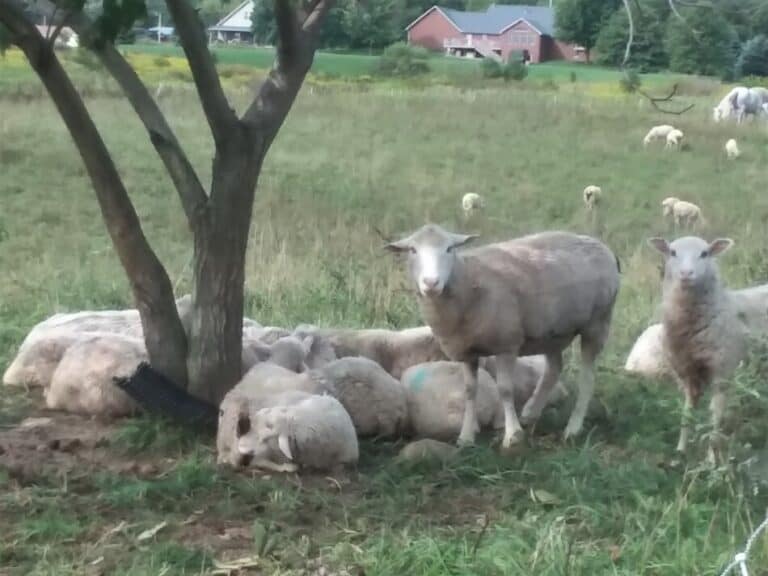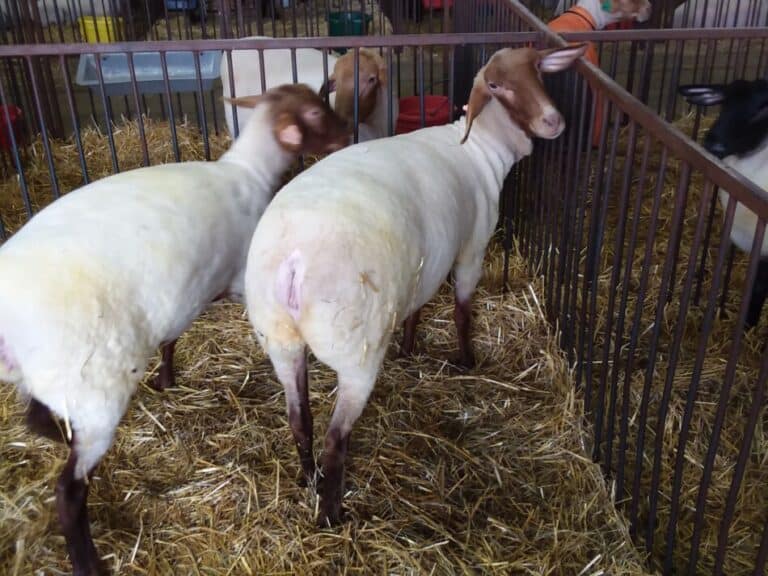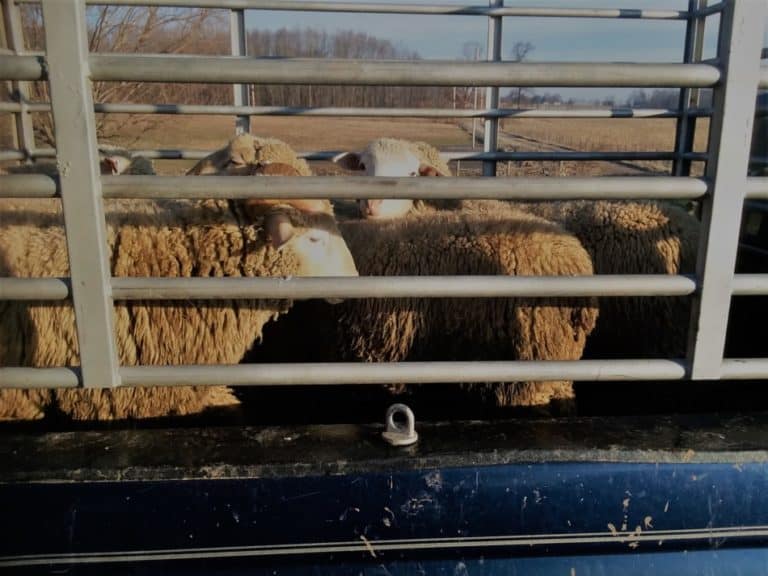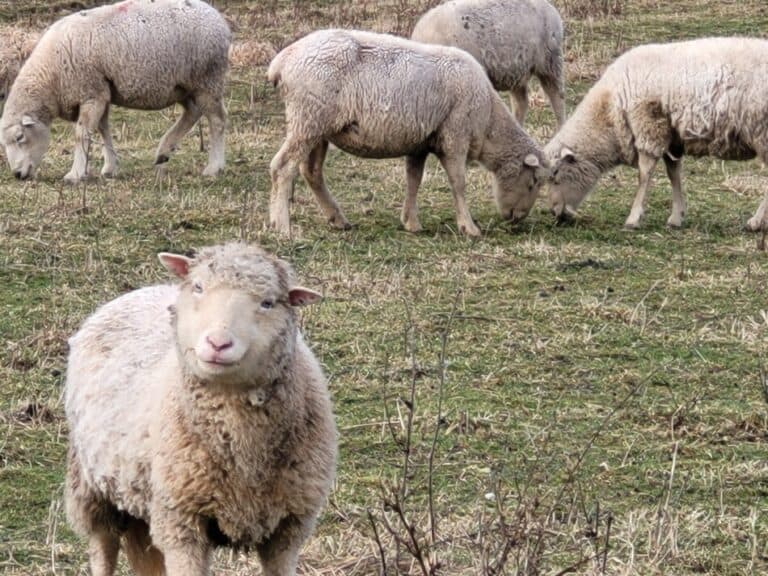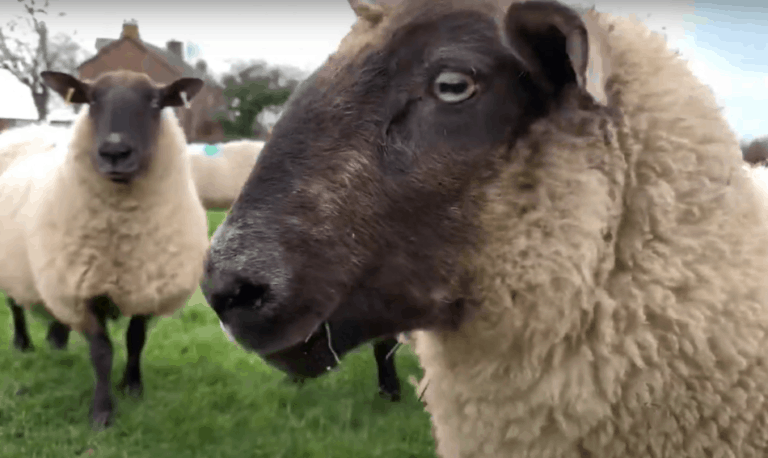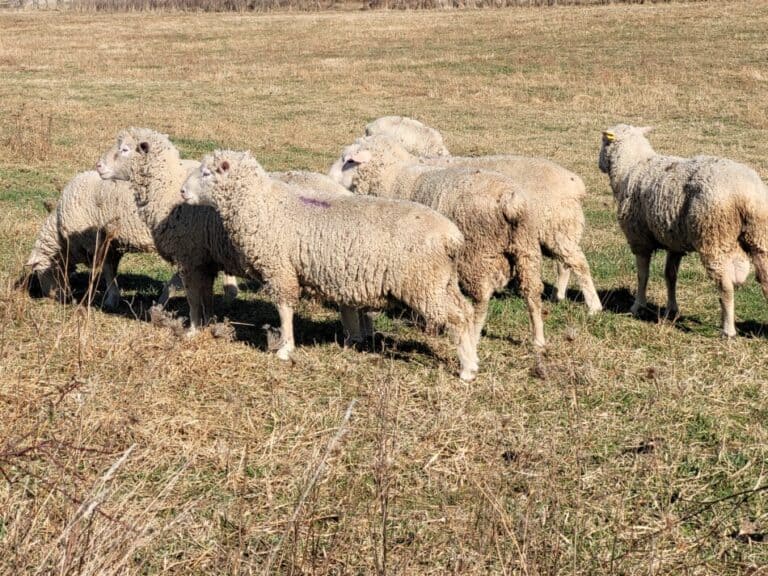Best Breeds Of Sheep For Meat
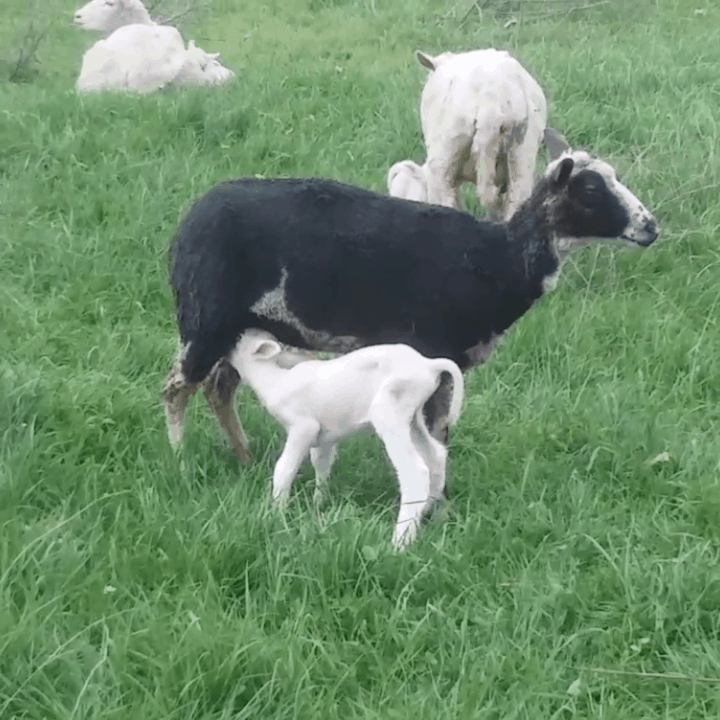
Sheep are wonderful livestock to raise that are finally becoming more popular. You’ve got quite a few choices, there are quite a few breeds of sheep!
What are the best breeds of meat sheep and how do you choose the one that will work best for you and your farm?
The best breeds of sheep for meat are: Cheviot, Dorset, Dorper, Hampshire, Katahdin, Shropshire, Southdown, Suffolk and Texel. These breeds are popular as both purebred sheep and for use as terminal sires.
I’ve broken this article down into 3 sections, breeds for meat, better moms (ewes to cross with a meat breed ram, if you want to have more maternal ability in your flock) and how to figure out what type of lamb will work best for you.
With few exceptions, all sheep, whether they are raised to produce market lambs or wool, are used for meat eventually. “Meat breeds” are simply selected more heavily for carcass traits than other traits.
Raising Sheep For Profit goes over the numbers of raising sheep and shows you how to find the prices for your area.
9 of the best sheep breeds for meat
The most popular breeds of sheep for meat are:
- Cheviot
- Dorset
- Dorper
- Hampshire
- Katahdin
- Shropshire
- Southdown
- Suffolk
- Texel
These 9 sheep are the all stars of lamb production, at least in the U.S. These sheep are breeds that are known for producing growthy, well filled out lambs that produce a nice carcass.
The specific breed you choose should be based on what exactly you want from your sheep. Scroll down to the “Type of sheep best for meat” section to get an idea of the selection parameters you might want to consider.
Pros And Cons Of Raising Sheep is a nice overview of the good and the not so good parts of shepherding.
| Breed | Appearance | Known for |
| Cheviot | all white, no wool on face or head | choice 40-60 pound lambs spunky lambs |
| Dorset | all white | great moms an all round type sheep |
| Dorper | hair sheep, black head and white body or all white | meaty lambs largest hair sheep |
| Hampshire | dark head, white body | larger market lambs crossbreeding sire |
| Katahdin | hair sheep, many colors | great moms all round type hair sheep |
| Shropshire | dark head, white body | larger market lambs crossbreeding sire |
| Southdown | lightly colored face, white body, shorter sheep | choice 40-60 pound lambs smaller market lambs |
| Suffolk | shiny black head, white body, taller sheep | larger market lambs crossbreeding sire |
| Texel | all white, no wool on head, distinctly wide build | choice 40-60 pound lambs chunky market lambs |
You’ll notice that there are a few distinct groupings of the sheep listed above, which are basically white face, black face and hair sheep.
From a production standpoint, it does not matter much which breed you choose (aside from shearing) as long as the lambs are well finished, but your buyers may prefer one look of lamb over another.
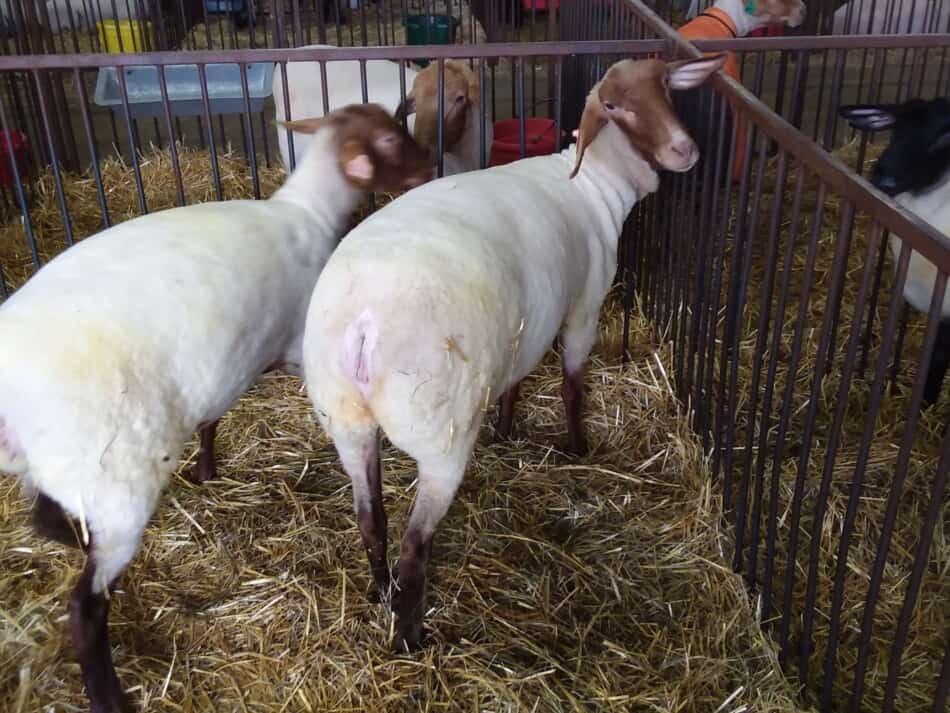
10 breeds that are great moms (for better market lambs)
Now, we move to the ewe flock and the idea of producing crossbred lambs, which is something that you may not have considered.
There is nothing wrong with purebred lambs, of course! If you like the list above, stick with the breed that will give you the lambs you want.
However, if you want nice market lambs and more maternal ability on the part of the ewes consider producing crossbred lambs for your meat lambs. This is common in most bigger flocks producing market lambs.
Easy Breeds Of Sheep goes over a list of versatile, easy to raise sheep breeds that are good choices for just about anyone.
Sheep breeds that are great moms to produce purebred or crossbred lambs:
- Border Leicester
- Columbia
- Coopworth
- Dorset
- Katahdin
- North Country Cheviot
- Polypay
- Rambouillet
- Targhee
- Tunis
For dry, range type areas: consider Columbia, Rambouillet or Targhee.
For small farm flocks: consider Border Leicester, Coopworth, Dorset, Polypay or Tunis.
For sheep with an extended breeding season: consider Dorset, Katahdin, Polypay or Tunis.
For easy to care for, hardy sheep: consider North Country Cheviot or Katahdin.
While these breeds themselves are not specifically known for their market lamb production, they are known for being great moms and are popular to use as a ewe flock which is crossed with a meat type ram to produce market lambs.
The reason I include these breeds in a meat sheep list is that sometimes meat sheep, while capable of producing beautiful market lambs are not the best moms or do not have great lambing percentages.
Using maternal type ewes crossed with meat type rams will give you the best of both worlds, great moms that have and raise more lambs and nice carcass traits from the ram.
If both parents are from the meat group, you get one super lamb per mom, rather than two slightly less awesome but still very nice lambs that you get when you have maternal moms crossed with a meat group ram.
Why would you want the slightly less meaty lambs? Because you have two of them so for the money and time you have in the ewe, you will get twice as much income from her lambs when compared to selling the single lamb.
Type of sheep best for meat
The best type of sheep for meat is more of a question of what your area’s lamb buyers want in an ideal lamb. If you are your customer, then get the sheep that you want. If you are selling at least some of the lambs, read on.
Of course, you should be choosing a breed that suits you and your farm! But unless you are going to direct market all of your lambs to the customer, the local preferences for lamb type and size need to factor in to your plans.
How Much Will You Get For Your Lambs? shows you how to figure up the current prices for lambs in your area. Even if you plan to privately sell your lamb, you should know area prices and trends.
Here are some questions you should ask yourself before you get sheep:
- Is the 50 pound finished lamb popular with the local buyers? If this is the case, a Cheviot or Texel ram would produce these type of lambs for your market.
- Do the folks in your area want more of a 100-120 pound lamb, more for retail cuts, like chops? If so, you’ll want to have more size to the lambs, which would mean you’ll want a bigger sire, more like a Suffolk or a Hampshire.
- Do people in your area like white face, black face or speckle faced lambs? What about the looks of the wool? Shaggier fleeces vs more neat and tidy fleeces?
- Do the buyers in your area like hair lambs? Then consider Katahdin or Dorper. A word of caution here: while hair sheep are the fastest growing group of sheep currently, not all buyers like the lambs.
- Can you get a shearer in to shear the flock? This is a tough one for some areas. Just know that if other folks have wool sheep around you or there are market lambs or breeding stock sheep at the county fair someone in your area shears.
I know that some of these things seem like minor points, but at our local auction we can see a marked difference in the prices paid for a white faced tight wool lamb compared to a speckle faced shaggy one.
Is the lamb any different underneath? Apparently someone thinks so. You’ll need to spy around your area, in some areas these things seem to matter, in other areas, not at all.
Also, in my opinion, people overemphasize the problems of getting shearing done. Plenty of folks get their sheep shorn, every year. Stop into a few farms and ask how they handle shearing.
If you are a small flock, the charge to stop at your place will be high, per sheep. I want to be upfront about that, but go over the numbers of what the buyers in your area want. For us, the cost of shearing is more than worth it.
Here’s how I look at it: wool lambs are bringing a $0.20 premium over hair lambs, this is just what we have seen at the auction. If the lamb is 100 pounds, that’s $20 more per lamb.
Since we shear ewes, not lambs, and generally you get 1.5 lambs per ewe, that’s another $30 per ewe for getting the shearing done. Right now, the shearing costs us $5 per sheep, so we make $25 per sheep by shearing.
Granted, if or when the pricing evens out for hair lambs, this will not be the case, shearing will now be a cost to us. But, right now in our area, having wool sheep vs hair sheep is paying, even more than shearing.
When Is The Best Time To Sell Lambs? helps you figure out the seasonality of your lamb market so you can know when to sell your lambs to get better prices.
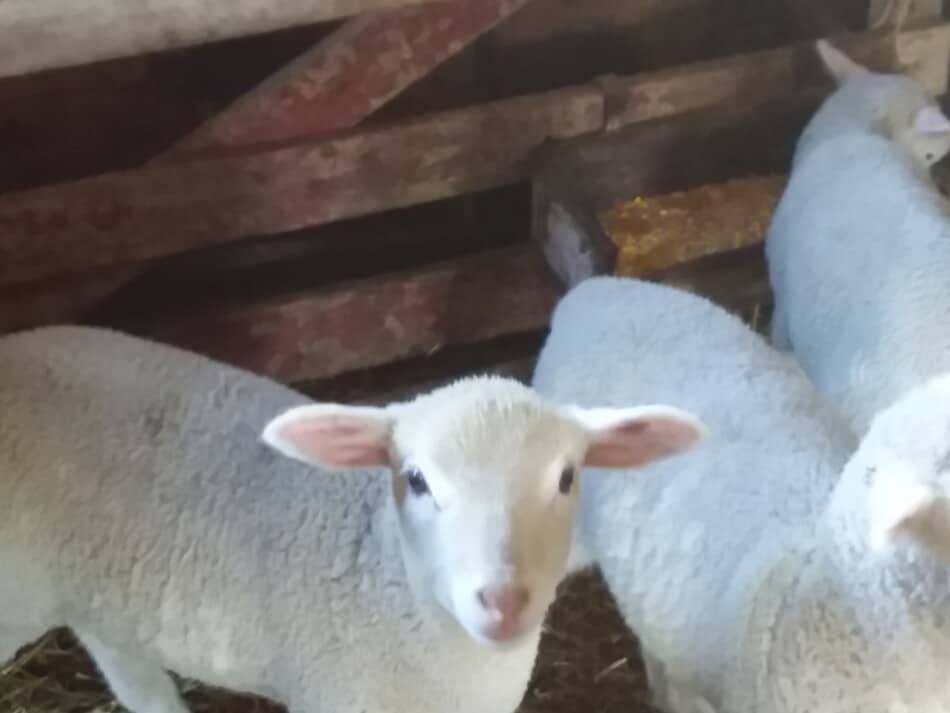
Certain types of lambs may be less attractive to buyers
I have no idea why, but, at least in my area (Ohio), we notice that hair sheep lambs at auction tend to get a bit lower of a price per pound, around $0.20 or so lower, than the price of a similar wool breed lamb.
Additionally, colored sheep and shaggy sheep seem to sell for a bit less, as well. Right now, our area buyers seem to prefer white faced tight wool lambs.
This is by no means universal and the price difference here could easily change over the next few years, but you should know that in some areas certain lambs sell better than others.
To get the scoop for your area, you’ll need to either attend a few auctions or, better yet, ask the folks eating the lamb what they prefer. In our experience, the perfect lamb varies by culture and intended use.
All sheep breeds can and are used for meat
All sheep have the potential to end up as meat animals, it’s just a matter of how good of a carcass are they able to produce.
If you are producing lambs for yourself, or just want a certain breed of sheep because you like their looks, super! Get the sheep that you like best.
If you are wanting to sell the lambs or get the breed or cross that will work the best in your area, now you need to do a bit of work first to figure out what you need then pick the breed that fits those criteria.
The easiest sheep to have for meat will be a more maternal ewe with a meat breed sire, for instance Dorset or Dorset cross ewes and a Texel or Suffolk ram.
Sheep Breeds is a wonderfully extensive list of sheep breeds put together by Oklahoma State University. I love to use this site as a resource, check it out for any sheep breed that you are interested in.
Sheep 101 is a wonderful site that is very beginner friendly. This is an article about the many types of sheep operations in the U.S. Click around on the site, there is a ton of great stuff here!
